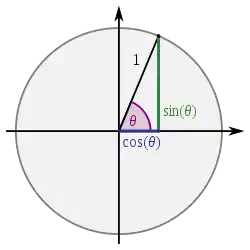Mollweide's formula
In trigonometry, Mollweide's formula, sometimes referred to in older texts as Mollweide's equations,[1] named after Karl Mollweide, is a set of two relationships between sides and angles in a triangle.[2]

Figure 1 – A triangle. The angles α, β, and γ are respectively opposite the sides a, b, and c.
| Trigonometry |
|---|
 |
| Reference |
| Laws and theorems |
| Calculus |
It can be used to check the consistency of solutions of triangles.[3]
Let a, b, and c be the lengths of the three sides of a triangle. Let α, β, and γ be the measures of the angles opposite those three sides respectively. Mollweide's formula states that
and
Each of these identities uses all six parts of the triangle—the three angles and the lengths of the three sides.
References
- Ernest Julius Wilczynski, Plane Trigonometry and Applications, Allyn and Bacon, 1914, page 102
- Michael Sullivan, Trigonometry, Dellen Publishing Company, 1988, page 243.
- Ernest Julius Wilczynski, Plane Trigonometry and Applications, Allyn and Bacon, 1914, page 105
Further reading
- H. Arthur De Kleine, "Proof Without Words: Mollweide's Equation", Mathematics Magazine, volume 61, number 5, page 281, December, 1988.
This article is issued from Wikipedia. The text is licensed under Creative Commons - Attribution - Sharealike. Additional terms may apply for the media files.